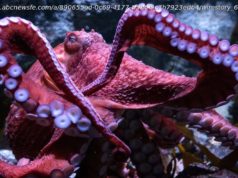Enceladus is considered a prime candidate for finding alien life, but scientists urge caution about the findings.
Enceladus was discovered by the British astronomer William Herschel in 1789 using what was then the largest telescope in the world, measuring 1.2m across.
Almost 230 years later, the Cassini spacecraft conducted another fly-past of its southern pole, travelling through one of the mysterious cryovolcanic plumes which had been discovered to be erupting from the moon.
Cassini sampled the water-rich plumes, suspected to originate from a vast liquid ocean beneath the surface of Enceladus, and discovered organic compounds – molecules which contain carbon and are essential to all known life.
These compounds, including the molecule methanol, have now been detected in a much more massive quantity than previously expected, using the IRAM radio telescope, which is 30 metres across, in the Spanish Sierra Nevada.
Scientists, including some from Imperial College London, are presenting their research into these compounds on 4 July at the UK’s National Astronomy Meeting which is being hosted by the University of Hull.
They have speculated that the organic compounds found in the water-rich plumes are formed as part of a complex chemical journey which the material vented from the moon undergoes after it is spewed into space.
Dr Emily Drabek-Maunder said: „Recent discoveries that icy moons in our outer solar system could host oceans of liquid water and ingredients for life have sparked exciting possibilities for their habitability.
„But in this case, our findings suggest that methanol is being created by further chemical reactions once the plume is ejected into space, making it unlikely it is an indication for life on Enceladus.“
Instead, the scientists believe that the enormous amount of methanol may have been produced by a cloud of gas expelled by Enceladus and trapped by Saturn’s magnetic field.
One team member, Dr Dave Clements from the Department of Physics at Imperial, stressed that „observations aren’t always straightforward“.
„To interpret our results, we needed the wealth of information Cassini gave us about Enceladus’s environment.
„This study suggests a degree of caution needs to be taken when reporting on the presence of molecules that could be interpreted as evidence for life.“
Later this year, Cassini will make its final plunge towards Saturn’s surface – ending the journey which it began when launched in 1997.
The orbiter will be written-off by crashing through Saturn’s atmosphere rather than risk damaging one of the planet’s moons which may yet be explored for signs of life.
Remote observations from telescopes based on Earth and in space will remain the only method for exploring Saturn and its potentially life-harbouring moons for now,
„This finding shows that detections of molecules at Enceladus are possible using ground-based facilities, “ said Dr Drabek-Maunder.
„However, to understand the complex chemistry in these subsurface oceans, we will need further direct observations by future spacecraft flying through Enceladus’s plumes.“






